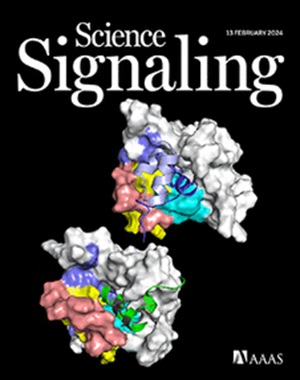Fusobacterium nucleatum enhances amphetamine-induced behavioral responses through a butyrate-driven epigenetic mechanism
IF 6.6
1区 生物学
Q1 BIOCHEMISTRY & MOLECULAR BIOLOGY
引用次数: 0
Abstract
Amphetamines are psychostimulants that are commonly used to treat neuropsychiatric disorders and are prone to misuse. The pathogenesis of amphetamine use disorder (AUD) is associated with dysbiosis (an imbalance in the body’s microbiome) and bacterially produced short-chain fatty acids (SCFAs), which are implicated in the gut-brain axis. Amphetamine exposure in both rats and humans increases the amount of intestinal Fusobacterium nucleatum, which releases SFCAs. Here, we found that colonization of gnotobiotic Drosophila melanogaster with F. nucleatum or supplementing the flies’ diet with the SCFA butyrate enhanced the psychomotor and reward properties of amphetamine. Butyrate inhibits histone deacetylases (HDACs), and knockdown of HDAC1 recapitulated the effects induced by F. nucleatum or butyrate. The enhancement in amphetamine-induced behaviors was mediated by an increase in the amount of released dopamine that resulted from amphetamine-induced reversal of dopamine transporter (DAT) function, termed nonvesicular dopamine release (NVDR). The magnitude of amphetamine-induced NVDR was partially mediated by an increase in DAT abundance stimulated at a transcriptional level, and the administration of F. nucleatum or butyrate enhanced NVDR by increasing DAT expression. The findings indicate that F. nucleatum supports AUD through epigenetic regulation of dopamine signaling and identify potential targets for AUD treatment.
核梭杆菌通过丁酸盐驱动的表观遗传机制增强安非他明诱导的行为反应
安非他明是一种精神兴奋剂,通常用于治疗神经精神疾病,容易被滥用。安非他明使用障碍(AUD)的发病机制与生态失调(体内微生物组的不平衡)和细菌产生的短链脂肪酸(SCFAs)有关,后者与肠脑轴有关。在大鼠和人体内暴露安非他明会增加肠道核梭杆菌的数量,而核梭杆菌会释放SFCAs。本研究发现,将黑腹果蝇定植于有核梭菌或在果蝇的饮食中添加丁酸SCFA可增强安非他明的精神运动和奖励特性。丁酸盐抑制组蛋白去乙酰化酶(HDACs),而HDAC1的敲低再现了核仁梭菌或丁酸盐诱导的作用。安非他明诱导的行为增强是由安非他明诱导的多巴胺转运体(DAT)功能逆转(称为非囊性多巴胺释放(NVDR))导致的多巴胺释放量增加介导的。安非他明诱导的NVDR的程度部分是由转录水平上刺激的DAT丰度增加介导的,而核仁梭菌或丁酸盐通过增加DAT表达来增强NVDR。研究结果表明,核梭菌通过多巴胺信号的表观遗传调控支持AUD,并确定了AUD治疗的潜在靶点。
本文章由计算机程序翻译,如有差异,请以英文原文为准。
求助全文
约1分钟内获得全文
求助全文
来源期刊

Science Signaling
BIOCHEMISTRY & MOLECULAR BIOLOGY-CELL BIOLOGY
CiteScore
9.50
自引率
0.00%
发文量
148
审稿时长
3-8 weeks
期刊介绍:
"Science Signaling" is a reputable, peer-reviewed journal dedicated to the exploration of cell communication mechanisms, offering a comprehensive view of the intricate processes that govern cellular regulation. This journal, published weekly online by the American Association for the Advancement of Science (AAAS), is a go-to resource for the latest research in cell signaling and its various facets.
The journal's scope encompasses a broad range of topics, including the study of signaling networks, synthetic biology, systems biology, and the application of these findings in drug discovery. It also delves into the computational and modeling aspects of regulatory pathways, providing insights into how cells communicate and respond to their environment.
In addition to publishing full-length articles that report on groundbreaking research, "Science Signaling" also features reviews that synthesize current knowledge in the field, focus articles that highlight specific areas of interest, and editor-written highlights that draw attention to particularly significant studies. This mix of content ensures that the journal serves as a valuable resource for both researchers and professionals looking to stay abreast of the latest advancements in cell communication science.
 求助内容:
求助内容: 应助结果提醒方式:
应助结果提醒方式:


